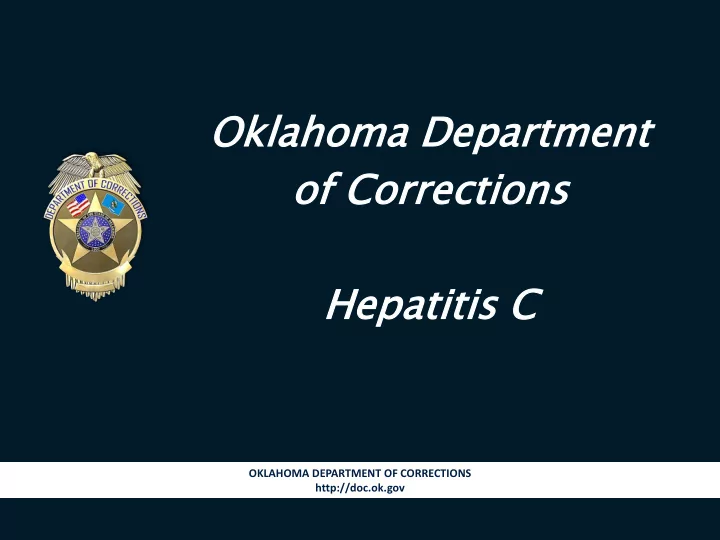

Okla lahoma oma De Depart rtment ment of Co f Corr rrecti ctions ons Hepati atiti tis s C OKLAHOMA DEPARTMENT OF CORRECTIONS http://doc.ok.gov
Hepatitis C Prevalence: Percentages Infected with Hepatitis C 18 16 14 12 10 8 6 4 2 0 General Public 1% National Prison Oklahoma Prison Average 17% Average 12%
HCV Chronic Clinic Data FY 2013-2019 Hepatitis C Inmates Enrolled in Chronic Clinic 3,500 3,000 2,500 2,000 1,500 1,000 500 0 FY 2013 FY 2014 FY 2015 FY 2016 FY 2017 FY 2018 FY 2019 19-Sep Inmates with HCV 1,578 2,093 2,179 2,276 2,544 3,038 3,107 3,118
Intake Screening: Initial Physical Examination and Laboratory Requirements: Medical, dental and mental health screenings are conducted by a qualified health care professional on all inmates upon arrival at the assessment and reception center • Complete Blood Count test (CBC) • Comprehensive Metabolic Panel test (CMP) • Cholesterol/Lipid Profile • Tuberculin Skin test • HIV/STD test • For female inmates: pregnancy test and if 40 or older, mammography.
How We Screen: Hepatitis C Evaluation and management of HCV includes 5 basic steps: • Step 1 : Test for Hepatitis C Infection. Per current policy, HCV testing is initiated as a result of a physician’s request due to identified risk factors, (exposure to bloodborne pathogens, e.g., tattooing, needle sticks, etc.) or inmate request.
How We Treat: • Step 2 : Perform a baseline evaluation of inmates who are HCV positive: • Targeted history and physical exam • Lab tests and ultrasound • Step 3: Assess for hepatic cirrhosis/compensation and priority criteria for treatment: • Evidence of Liver Fibrosis/Cirrhosis • APRI and FIB-4 • Comorbidities
How We Treat: • Step 4 : Perform a pretreatment exam. If priority criteria for treatment are met: • Agreement for Treatment • Patient Education • Initiate DAA Regimen • Step 5: Monitor patient during and after treatment: • Nurse Monitoring Twice Monthly • Post-Treatment Lab Requirements
How We Treat: The Medications Used Direct Acting Antivirals (DAA) currently on the market have a greater than 90% cure rate for Hepatitis C. • Epclusa (sofosbuvir/velpatasvir) 12 week course (1 tablet daily) $23,219.37, approximately $276.43 per day • Mavyret (glecaprevir/pibrentasvir ) 8 week course (3 tablets daily)$29,539.29, approximately $527.49 per day
How We Treat: The Medications Used • Zepatier (elbasvir and grazoprevir) 12 week course (1 tablet daily) $13,206, approximately $157.22 per day • Vosevi (sofosbuvir, velpatasvir, and voxilaprevir) 12 week course (1 tablet daily) $62,080.77, approximately $739.06 per day
Consequences of Not Treating Hepatitis C: Hepatitis C is treatable. Over time, failure to treat Hepatitis C could cause the following complications: • Cirrhosis • Liver damage • Chronic liver disease • Esophageal Varices • Hepatic Encephalopathy/Liver Failure • Liver Cancer • Death
Hospitalization Caused by Hepatitis C Lindsay Municipal Hospital: FY 2018 $528,039.13 $525,000.00 $389,830.76 $425,000.00 $325,000.00 $225,000.00 $125,000.00 $74,139.69 $50,398.33 $25,000.00 Cirrhosis Chronic Liver Hepatitis C Liver Cancer Disease
Hepatitis C Public Health Considerations • Target and provide treatment to inmates infected with Hepatitis C. • Statistics show 95 percent of all inmates will eventually be released. Treating the infected inmate population can stop the spread of the disease and improve public health. • The CDC states improved access to medical care and prevention services for incarcerated populations can benefit communities by reducing disease transmission and medical costs. • Primary prevention of HCV is directed at lowering the rate of HCV infection. Prevention should be aimed at those individuals who engage in the high risk activities for transmission behaviors, such as the inmate population.
Cost of Hepatitis C Treatment Hepatitis C Drug Cost FY 2016-FY 2019 $1,200,000.00 $1,000,000.00 $800,000.00 $600,000.00 $400,000.00 $200,000.00 $0.00 FY 2016 FY 2017 FY 2018 FY 2019 yearly cost $259,907.13 $419,112.79 $740,041.16 $1,109,296.28
Hepatitis C: Future Cost Considerations • From July 1-August 31, the agency has spent $1,447,745.80 of the $12 million provided in the FY 2020 budget on Hepatitis C treatment. It is anticipated that we will expend and possibly exceed the current funding. • Numerous states have had legal action taken against them regarding inmate access to HCV treatment.
Future ODOC Considerations Opt Out Testing • ODOC has developed a draft policy to incorporate an “opt - out” screening as part of the assessment and reception process. If initiated, an HCV antibody test would be performed on all inmates at the point of reception. • The HCV antibody lab panel is approximately $8.00 per lab. Approximately 10% of arrivals will test positive for Hepatitis C and will require confirmatory HCV-RNA testing at a cost of $75.00 per test. Based on current reception rates, it is estimated that $175,000 of FY 2021 funding would be dedicated to this screening.
Recommend
More recommend